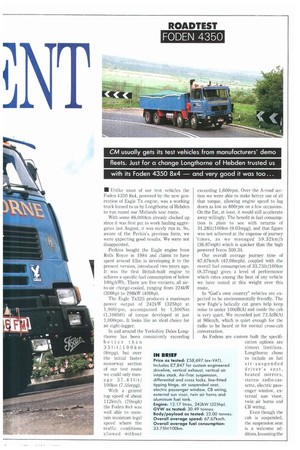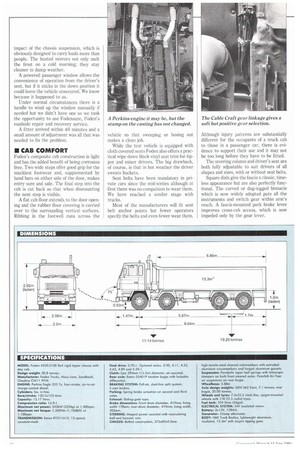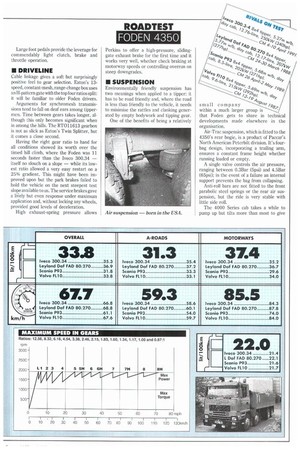• Unlike most of our test vehicles the Foden 4350
Page 25

Page 26

Page 27

If you've noticed an error in this article please click here to report it so we can fix it.
8x4, powered by the new generation of Eagle Tx engine, was a working truck loaned to us by Longthorne of Hebden to run round our Midlands test route.
With some 86,000km already clocked up since it was first put to work hauling aggregates last August, it was nicely run in. So, aware of the Perkin's previous form, we were expecting good results. We were not disappointed.
Perkins bought the Eagle engine from Rolls Royce in 1984 and claims to have spent around .Y5m in developing it to the present version, introduced two years ago. It was the first British-built engine to achieve a specific fuel consumption of below 190g/kWh. There are five variants, all airto-air charge-cooled, ranging from 224kW (300hp) to 298kW (400hp).
The Eagle Tx325 produces a maximum power output of 242kW (325hp) at 1,900rpm, accompanied by 1,500Nm (1,106lbft) of torque developed at just 1,000rpm. It looks like an ideal choice for an eight-legger.
With a geared top speed of about 112km/h (70mph) the Foden 8x4 was well able to maintain maximum legal speed where the traffic conditions allowed without
exceeding 1,600rpm. Over the A-road section we were able to make better use of all that torque, allowing engine speed to lug down as low as 800rpm on a few occasions, On the flat, at least, it would still accelerate away willingly. The benefit in fuel consumption is plain to see with returns of 31.281it/100km (9.03mpg), and that figure was not achieved at the expense of journey -times, as we managed 59.32km1h (36.87mph) which is quicker than the high powered Iveco 300,34,
Our overall average journey time of 67.67km/h (42.06mph), coupled with the overall fuel consumption of 33.751it/100km (8.37mpg) gives a level of performance which rates among the best of any vehicle we have tested at this weight over this route.
"Cod's own country" vehicles are expected to be environmentally friendly. The new Eagle's helically cut gears help keep noise to under 100dB(A) and inside the cab is very quiet. We recorded just 72.5dB(A) at 96km/h, which is quiet enough for the radio to be heard or for normal cross-cab conversation.
As Fodens are custom built the specification options are almost limitless. Longthorne chose to include an lsri air-suspended driver's seat, heated mirrors, stereo radio-cassette, electric passenger window, external sun visor, twin air horns and CB wiring.
Even though the cab is suspended, the suspension seat is a welcome addition, lessening the impact of the chassis suspension, which is obviously designed to carry loads more than people. The heated mirrors not only melt the frost on a cold morning; they stay cleaner in damp weather.
A powered passenger window allows the convenience of operation from the driver's seat, but if it sticks in the down position it could leave the vehicle unsecured. We know because it happened to us.
Under normal circumstances there is a handle to wind up the window manually if needed but we didn't have one so we took the opportunity to use Fodensure, Foden's roadside repair and recovery service.
A fitter arrived within 40 minutes and a small amount of adjustment was all that was needed to fix the problem.
• CAB COMFORT
Foden's composite cab construction is light and has the added benefit of being corrosion free. Two wide steps offer good grip for the muckiest footwear and, supplemented by hand bars on either side of the door, makes entry sure and safe. The final step into the cab is cut back so that when dismounting the next step is visible, A flat cab floor extends to the door opening and the rubber floor covering is carried over to the surrounding vertical surfaces. Ribbing in the footwell runs across the vehicle so that sweeping or hosing out makes a clean job.
While the test vehicle is equipped with cloth covered seats Foden also offers a practical wipe down black vinyl seat trim for tipper and mixer drivers. The big drawback, of course, is that in hot weather the driver sweats buckets.
Seat belts have been mandatory in private cars since the mid-sixties although at first there was no compulsion to wear them. We have reached a similar stage with trucks.
Most of the manufacturers will fit seat belt anchor points but fewer operators specify the belts and even fewer wear them. Although injury patterns are substantially different for the occupants of a truck cab to those in a passenger car, there is evidence to support their use and it may not be too long before they have to be fitted.
The steering column and driver's seat are both fully adjustable to suit drivers of all shapes and sizes, with or without seat belts.
Square dials give the fascia a classic, timeless appearance but are also perfectly functional. The curved or dog-legged binnacle which is now widely adopted puts all the instruments and switch gear within arm's reach. A fascia-mounted park brake lever improves cross-cab access, which is now impeded only by the gear lever.
Large foot pedals provide the leverage for commendably light clutch, brake and throttle operation.
• DR1VELINE Cable linkage gives a soft but surprisingly positive feel to gear selection. Eaton's 13speed, constant-mesh, range-change box uses an I-I-pattern gate with the top four ratios split: it will be familiar to older Foden drivers.
Arguments for synchromesh transmissions tend to fall on deaf ears among tippermen. Time between gears takes longer, although this only becomes significant when in among the hills. The RT011613 gearbox is not as slick as Eaton's Twin Splitter, but it comes a close second.
Having the right gear ratio to hand for all conditions showed its worth over the timed hill climb, where the Foden was 11 seconds faster than the Iveco 300.34 itself no slouch on a slope while its lowest ratio allowed a very easy restart on a 25% gradient. This might have been improved upon but the park brakes failed to hold the vehicle on the next steepest test slope available to us, The service brakes gave a lively but even response under maximum application and, without locking any wheels, provided good levels of deceleration.
High exhaust-spring pressure allows




































































































